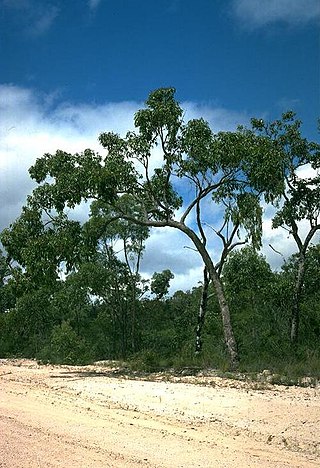
Corymbia abergiana, commonly known as range bloodwood or Rockingham Bay bloodwood, is a species of tree that is endemic to Queensland. It has rough bark on the trunk and larger branches, smooth bark on the smaller branches, lance-shaped adult leaves, flower buds in groups of seven, creamy white flowers and barrel-shaped fruit with a very thick rim.

Corymbia henryi, commonly known as large-leaved spotted gum, is a species of small to medium-sized tree that is endemic to north-eastern Australia. It has smooth, mottled bark, lance-shaped adult leaves, flower buds in groups of three, white or lemon yellow flowers and barrel-shaped to urn-shaped fruit.
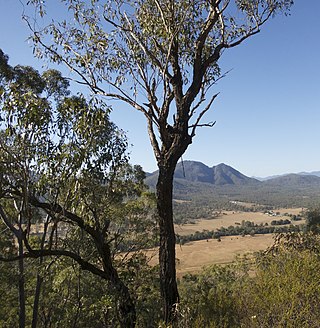
Eucalyptus dura is a species of small to medium sized tree that is endemic to south-eastern Queensland. It has rough, dark grey to black "ironbark", lance-shaped adult leaves, flower buds in groups of seven, white flowers and conical fruit.

Corymbia aureola, commonly known as yellowjacket or yellow bloodwood, is a species of tree that is endemic to Queensland. It has rough bark on the trunk and larger branches, lance-shaped to curved adult leaves, flower buds in groups of seven and barrel-shaped, urn-shaped or cylindrical fruit.

Corymbia bleeseri, commonly known as glossy-leaved bloodwood or smooth-stemmed bloodwood, is a species of tree that is endemic to northern Australia. It has thin, rough bark on part or all of the trunk, smooth bark above, lance-shaped to curved adult leaves, flower buds in groups of seven, creamy white flowers and barrel-shaped fruit.

Corymbia collina, commonly known as silver-leaved bloodwood, is a species of tree that is endemic to Western Australia. It has thin patchy rough bark on some or all of the trunk, smooth white to pale grey bark above, lance-shaped to curved adult leaves, flower buds in groups of seven, creamy white flowers and barrel-shaped fruit.

Corymbia erythrophloia, commonly known as red bloodwood, variable-barked bloodwood, red-barked bloodwood or gum-topped bloodwood, is a species of tree that is endemic to Queensland. It has rough bark on the trunk and branches, egg-shaped or lance-shaped adult leaves, flower buds in groups of seven, creamy white flowers and urn-shaped to spherical fruit.
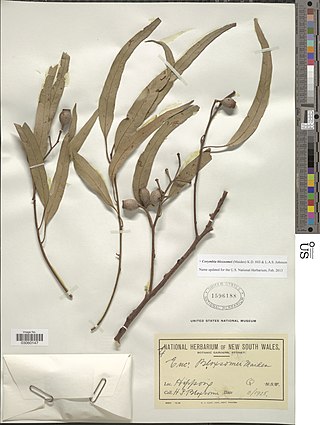
Corymbia bloxsomei, commonly known as yellowjack, yellow jacket or yellow bloodwood, is a species of tree that is endemic to inland, south-eastern Queensland. It has thick, rough scaly bark on the trunk and larger branches, lance-shaped or curved adult leaves, flower buds in groups of seven, nine or eleven, creamy white to pale yellow flowers and barrel-shaped, urn-shaped or spherical fruit.

Corymbia brachycarpa is a species of tree that is endemic to central Queensland. It has rough, tessellated bark on the trunk and branches, lance-shaped adult leaves, flower buds in groups of seven, creamy white flowers and urn-shaped to barrel-shaped fruit.
Corymbia clandestina, commonly known as Drummond Range bloodwood, is a species of small tree that is endemic to Queensland. It has rough, tessellated bark on the trunk and branches, lance-shaped adult leaves, flower buds in groups of seven, white flowers and urn-shaped to barrel-shaped fruit.
Corymbia ellipsoidea is a species of tree that is endemic to Queensland. It has rough bark on the trunk and larger branches, lance-shaped adult leaves, flower buds usually in groups of seven, creamy white flowers and barrel-shaped to urn-shaped fruit.
Corymbia lamprophylla, commonly known as shiny-leaved bloodwood, is a species of tree that is endemic to central Queensland. It has rough, tessellated bark on the trunk and larger branches, lance-shaped adult leaves, flower buds in groups of seven, creamy white flowers and urn-shaped fruit.
Corymbia petalophylla is a species of tree that is endemic to Queensland. It has rough, tessellated bark on the trunk and branches, lance-shaped or curved adult leaves, flower buds in groups of seven, white flowers and barrel-shaped, urn-shaped or shortened spherical fruit.
Corymbia rhodops, commonly known as red-throated bloodwood, is a species of tree that is endemic to Queensland. It has rough, tessellated bark on the trunk and larger branches, lance-shaped adult leaves, flower buds in groups of seven, creamy white flowers with a red centre, and urn-shaped to barrel-shaped fruit.
Corymbia stockeri, commonly known as blotchy bloodwood, is a species of small tree that is endemic to Cape York Peninsula in Queensland. It has rough, tessellated bark on the trunk and branches, lance-shaped adult leaves, flower buds in groups of seven, creamy white flowers and barrel-shaped to urn-shaped fruit.
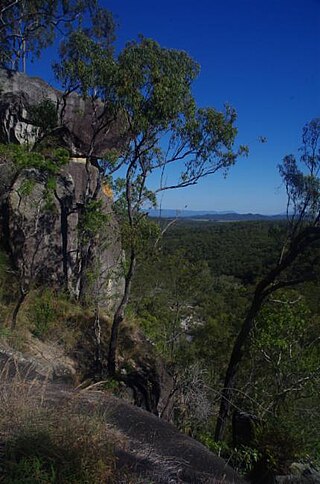
Eucalyptus granitica, commonly known as the granite ironbark, is a species of tree that is endemic to Queensland. It has dark grey or black "ironbark" on the trunk and branches, glossy green, lance-shaped to curved adult leaves, flower buds in groups of seven, white flowers and cup-shaped to barrel-shaped fruit.
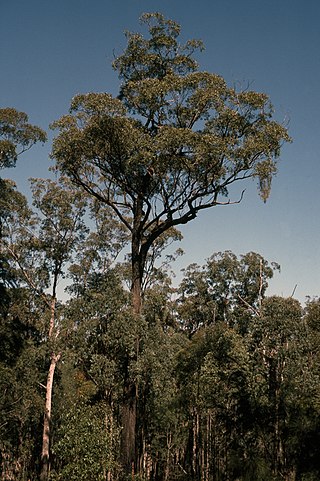
Eucalyptus melanoleuca, commonly known as yarraman ironbark or nanango ironbark, is a species of tree that is endemic to south-east Queensland. It has rough ironbark on the trunk and larger branches, smooth bark above, lance-shaped adult leaves, flower buds in groups of seven, white flowers and barrel-shaped, to cup-shaped or conical fruit.

Eucalyptus persistens is a species of small tree that is endemic to Queensland. It has rough, dark grey bark, lance-shaped adult leaves, flower buds in groups of seven, white flowers and cup-shaped or barrel-shaped fruit.

Eucalyptus rhombica is a small to medium-sized tree that is endemic to a small area of south-east Queensland. It has rough, ironbark on the trunk and larger branches, smooth bark above, lance-shaped adult leaves, flower buds in groups of seven, white flowers and cup-shaped or conical fruit.
Eucalyptus sicilifolia is a species of small ironbark tree that is endemic to Queensland. It has dark ironbark on the trunk and branches, narrow lance-shaped to curved adult leaves, flower buds in groups of seven, white flowers and cup-shaped to barrel-shaped fruit.













